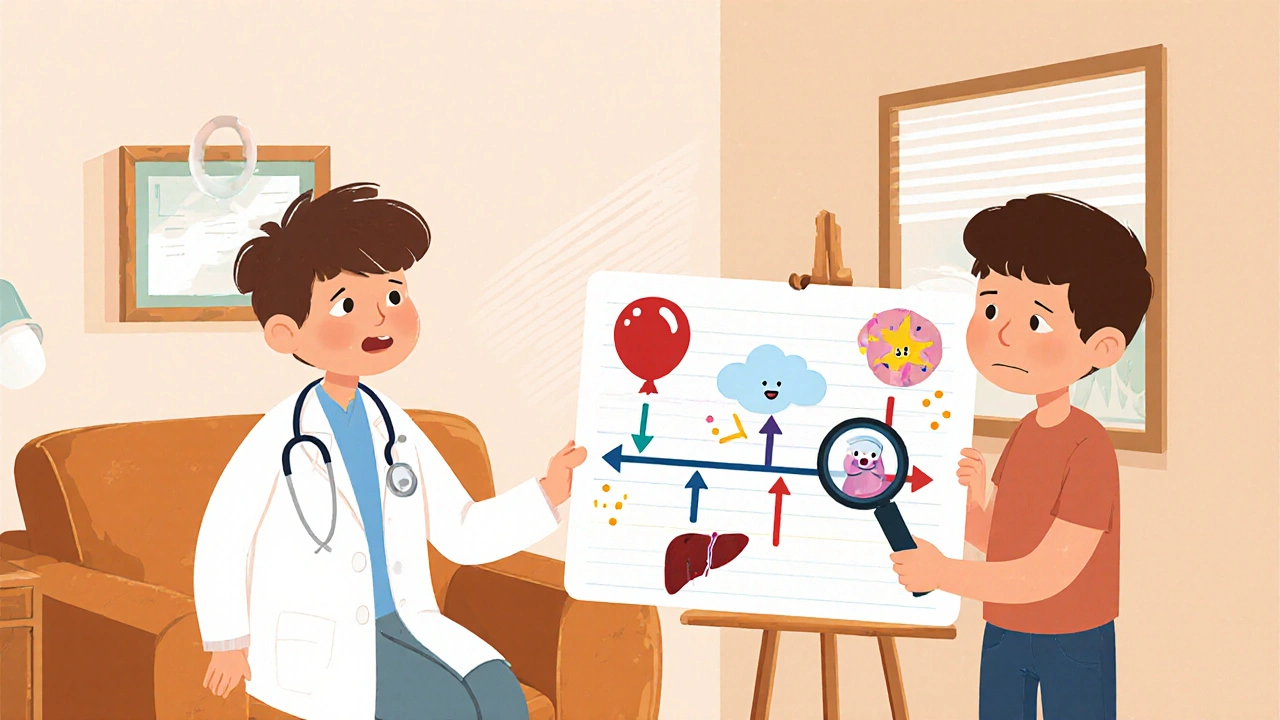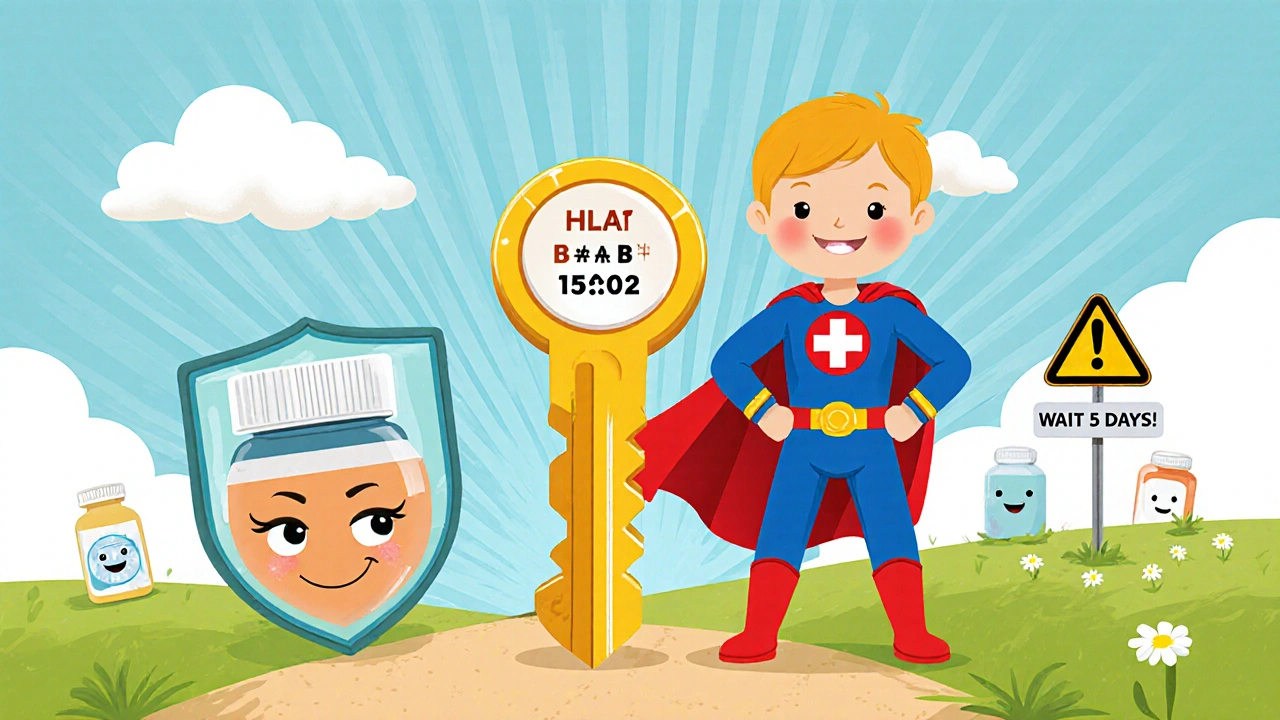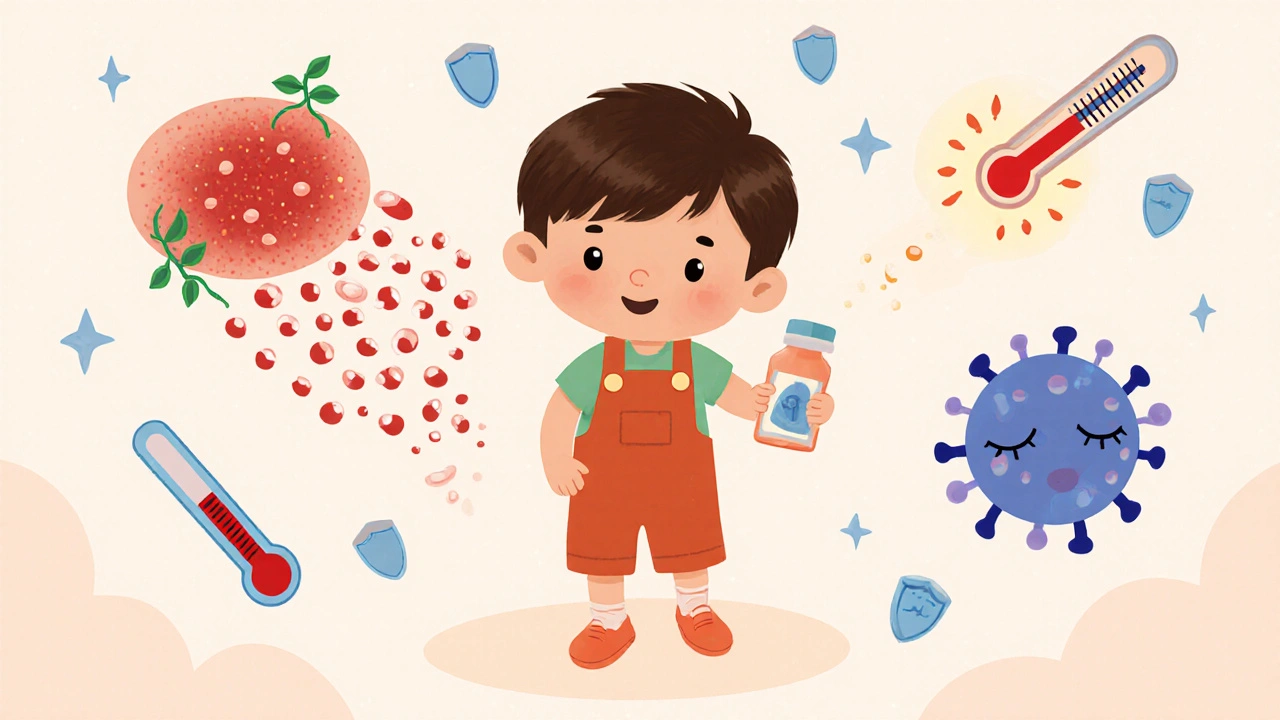Most people know that some medications can cause side effects-nausea, dizziness, or a rash-right after taking them. But what if the reaction doesn’t show up until days or even weeks later? That’s when things get dangerous. Delayed drug reactions aren’t just annoying rashes. They can be life-threatening, and too often, they’re missed because doctors and patients don’t connect the dots between a drug taken two weeks ago and a fever or blistering skin that’s now spreading.
Why Delayed Reactions Are Different
Not all drug reactions are the same. If you break out in hives five minutes after taking penicillin, that’s an immediate, IgE-mediated reaction. Your body reacts fast. But delayed reactions? Those are driven by your immune system’s T-cells, not antibodies. They take time to wake up. That’s why symptoms often appear between 5 days and 8 weeks after you started the medication. These aren’t random glitches. They’re precise immune responses triggered by specific drugs. The most common culprits? Antibiotics like sulfamethoxazole, anticonvulsants like carbamazepine and lamotrigine, and painkillers like ibuprofen or naproxen. The timing isn’t random either. Beta-lactam antibiotics usually cause reactions within 2 weeks. But anticonvulsants? Nine out of ten times, the reaction won’t show up until after two weeks-sometimes not until day 20 or 25.What These Reactions Look Like
The most common delayed reaction is a maculopapular exanthema-a flat, red rash with small bumps. It looks like measles. It starts on the chest or back, spreads slowly, and can last 1 to 3 weeks after you stop the drug. Many people think it’s a virus, especially if they had a cold or flu around the same time. But if you started a new medication 7 to 10 days before the rash appeared, it’s likely drug-related. Then there are the severe ones. These are rare, but deadly.- Stevens-Johnson Syndrome (SJS) and Toxic Epidermal Necrolysis (TEN): These start with flu-like symptoms-fever, sore throat, burning eyes. Then your skin begins to blister and peel. SJS affects less than 10% of your body surface. TEN affects over 30%. Mortality? Up to 10% for SJS, and over 30% for severe TEN. The skin doesn’t just itch-it detaches.
- DRESS syndrome: Drug Reaction with Eosinophilia and Systemic Symptoms. This one creeps up. Fever over 38.5°C, swollen lymph nodes, high eosinophils (a type of white blood cell), and atypical lymphocytes. It often hits the liver-ALT levels can spike to over 1,000 U/L. It can also damage the kidneys, lungs, or heart. What’s scary? It can flare up again even after you think you’re getting better. Relapse at 3 to 4 weeks is common.
- AGEP: Acute Generalized Exanthematous Pustulosis. This one looks like a thousand tiny white pustules covering your skin. It comes on fast, peaks in 2 to 3 days, and clears within 10 to 15 days after stopping the drug. But it leaves behind dark spots that can linger for months.
Who’s at Risk?
It’s not just about the drug. Your genes matter. If you’re of Han Chinese, Thai, or Southeast Asian descent, carrying the HLA-B*15:02 gene means you have a 1,000-fold higher risk of developing SJS from carbamazepine. That’s not a small chance-it’s a red flag. In Thailand, doctors screen everyone before prescribing carbamazepine. In Australia and the U.S., they don’t. That’s a gap. HLA-B*58:01? That’s the gene linked to allopurinol-induced DRESS. In Thai patients, if you have this gene and take allopurinol, your chance of a severe reaction is nearly 100%. In European populations, this gene is rare-so the risk is low. Age matters too. Adults over 60 have more than double the rate of delayed reactions compared to kids. Why? Slower metabolism. More medications. Weaker immune regulation.
Why These Reactions Are Often Missed
Doctors are trained to think of infections first. A fever? Must be a virus. A rash? Probably chickenpox or measles. A swollen liver? Maybe hepatitis. A 2021 study found that 32% of early DRESS cases were misdiagnosed as viral infections. Patients were given antibiotics they didn’t need-and sometimes those antibiotics made the reaction worse. Another problem? Patients don’t connect the dots. They forget what meds they started three weeks ago. Or they assume the rash is "just a side effect" and keep taking the drug. That’s a mistake. Every day you keep taking the drug after symptoms start increases your risk of organ damage-and death.What to Do If You Suspect a Delayed Reaction
If you’re on a new medication and develop any of these symptoms after 5 days:- Fever above 38.5°C
- Widespread rash or blisters
- Swollen lymph nodes
- Jaundice (yellow skin or eyes)
- Swelling or pain in your joints
- Unexplained fatigue or nausea
How It’s Treated
The first and most important step? Stop the drug. That’s it. No other treatment works without it. For mild rashes, supportive care is enough: antihistamines, moisturizers, and time. For severe reactions like DRESS or SJS/TEN, you’ll likely need hospitalization. Treatment includes:- High-dose corticosteroids (like prednisone) to calm the immune system. Dosing starts at 0.5 to 1 mg per kg of body weight per day, then tapers slowly over 2 to 4 weeks. Stopping too fast can cause relapse.
- Cyclosporine for DRESS with liver or kidney involvement. One study showed it cleared symptoms 50% faster than steroids alone.
- IV fluids, wound care, and infection prevention-especially for SJS/TEN, where your skin barrier is gone.

Long-Term Effects
Even if you survive, you’re not out of the woods.- 35% of SJS/TEN survivors develop chronic eye problems-dryness, scarring, vision loss. They need lifelong ophthalmology care.
- 22% develop autoimmune disorders like lupus or thyroid disease within two years.
- For DRESS, skin hyperpigmentation can last 6 to 12 months. Some patients report lasting fatigue or nerve pain.
Can You Prevent This?
Yes-partly. In Taiwan, since 2015, doctors have been required to test for HLA-B*58:01 before prescribing allopurinol to patients of Asian descent. Result? Severe reactions dropped by 80%. Similar programs in Hong Kong and Thailand have shown the same. The FDA now recommends screening for HLA-B*15:02 before carbamazepine in high-risk populations. But in Australia and the U.S., it’s still optional. That’s a missed opportunity. Future tools are coming. Blood tests that measure T-cell responses (like lymphocyte transformation tests) are improving. New biomarkers like CXCL10 levels can predict DRESS severity with 87% accuracy. In five years, AI systems might scan your electronic health record and flag high-risk drug-gene combinations before you even get the prescription.What You Should Remember
Delayed drug reactions are not rare. They’re underdiagnosed. And they’re preventable-if you know the signs.- Any new rash, fever, or swelling that appears 5 to 50 days after starting a new drug? Think drug reaction.
- Don’t wait for symptoms to get worse. Stop the drug and get help immediately.
- Keep a list of all medications you take. Include supplements and OTCs.
- If you’ve had a severe reaction before, wear a medical alert bracelet.
- Ask your doctor: "Is this drug linked to any HLA genes I should know about?" Especially if you’re of Southeast Asian descent.
Can a delayed drug reaction happen after you’ve stopped the medication?
Yes. Some reactions, especially DRESS syndrome, can start or worsen even after you’ve stopped the drug. Symptoms may appear 1 to 4 weeks after discontinuation. This is why doctors advise monitoring for several weeks after stopping a suspected medication, even if you feel better.
Are delayed drug reactions more common in older adults?
Yes. Adults over 60 have more than double the risk compared to younger people. This is due to slower drug metabolism, more frequent use of multiple medications, and age-related changes in immune function. Older patients are also more likely to develop organ damage from these reactions.
Can you get a delayed reaction from over-the-counter drugs?
Absolutely. NSAIDs like ibuprofen and naproxen, as well as pain relievers like acetaminophen, have been linked to delayed rashes, DRESS, and even SJS. Many people assume OTC means safe, but any drug can trigger an immune response in susceptible individuals.
Is it safe to take the same drug again after a delayed reaction?
Never. Once you’ve had a severe delayed reaction like SJS, TEN, or DRESS, re-exposure can be fatal. Even mild reactions like maculopapular rash carry a 30-50% risk of recurrence. Always inform all your doctors and pharmacists about any past drug reactions.
What should you do if you think you had a delayed reaction?
Stop the medication immediately and seek medical attention. Bring a complete list of all medications taken in the past 6 weeks. Ask for a referral to an allergist or immunologist who specializes in drug hypersensitivity. Avoid future use of that drug and related medications in the same class.
Are there genetic tests available to prevent delayed drug reactions?
Yes, for specific drug-gene pairs. Testing for HLA-B*15:02 before carbamazepine and HLA-B*58:01 before allopurinol is recommended in high-risk populations (e.g., Southeast Asian ancestry). These tests are widely available in Australia and can be ordered through your doctor. While not all reactions are preventable this way, these two screenings can prevent the majority of life-threatening cases.



Comments (14)
Rusty Thomas
Okay but like... I took ibuprofen for a headache last month and woke up with this weird rash? Thought it was just stress. Now I'm panic-scrolling through every article ever written about DRESS syndrome. 😭
rob lafata
Typical American healthcare. We wait until someone’s skin is peeling off like a burnt marshmallow before we even consider a drug reaction. Meanwhile, Thailand’s been screening for HLA genes since 2005. We’re still letting people die because someone’s insurance won’t cover a $50 genetic test. Pathetic.
Matthew McCraney
They’re hiding this on purpose. Big Pharma knows these reactions are deadly but they don’t want you to know how many drugs cause them. Why? Because if you stopped taking every single one of those meds after 5 days, their stock would crash. I’ve seen the leaked emails. They call it ‘delayed profit.’
serge jane
It’s fascinating how our immune system can turn against us so slowly and precisely. It’s not a flaw-it’s a misfire in an otherwise brilliant system. We evolved to detect foreign invaders fast, but drugs aren’t invaders, they’re molecules we invited in. The T-cells get confused, think they’re fighting a virus, and go full scorched earth. And we punish the body for doing its job too well. Maybe we need to rethink what ‘side effect’ even means.
Nick Naylor
....WE NEED NATIONAL STANDARDS. NOW. NOT OPTIONAL. NOT ‘RECOMMENDED.’. WE ARE NOT A THIRD WORLD COUNTRY. WE HAVE THE TECHNOLOGY. WE HAVE THE DATA. WE HAVE THE RESOURCES. AND YET WE LET PEOPLE DIE BECAUSE SOME DOCTOR ‘FORGOT’ TO CHECK A GENE? THAT’S NOT MEDICINE. THAT’S NEGLIGENCE. AND IT’S UNACCEPTABLE.
Brianna Groleau
I’m from a small town in Ohio and my grandma got DRESS from allopurinol. She was 72. They thought it was hepatitis. She spent 3 weeks in ICU. When she got home, her skin was still dark for a year. I didn’t know any of this until I read this post. Now I make sure my whole family has a meds list on their phone. And I ask every doctor: ‘Could this trigger something bad?’ It’s not paranoia-it’s protection.
Dave Wooldridge
They’re putting chemo drugs in your Advil. That’s what’s happening. The FDA doesn’t test for this because they’re paid off by Big Pharma. The pustules? That’s not a reaction-that’s your body trying to expel nanotech. They’ve been embedding tracking chips in pills since 2018. You think that’s a coincidence? Look at the rise in delayed reactions. It’s not random. It’s targeted.
Rebecca Cosenza
Stop the drug. Go to ER. No excuses. 🙏
swatantra kumar
Bro in India we’ve been doing this for decades. My uncle got DRESS from carbamazepine in 2012. Now every doctor here checks HLA-B*15:02 before prescribing. We don’t wait for skin to fall off. 😎 But yeah, US still thinks ‘natural remedies’ fix everything. Bless your hearts.
Cinkoon Marketing
Just FYI, I’m a medical writer and I’ve seen this so many times. Patients come in with rashes and say ‘oh I took some melatonin and ibuprofen last week’-and the doctor just says ‘it’s probably allergies.’ No one connects the dots until it’s too late. The real tragedy is that this is 100% avoidable with basic patient education. Why aren’t we doing it?
robert cardy solano
I had a maculopapular rash after starting lamotrigine. Thought it was just a side effect. Kept taking it. Three weeks later I was in the hospital with liver enzymes through the roof. Never took another anticonvulsant. I still get anxious every time I see a new prescription. Just… ask questions. Even if it feels dumb.
Pawan Jamwal
HAHAHAHA US doctors still don’t screen? 😂 In India we test for HLA-B*58:01 before even thinking of giving allopurinol to anyone over 40. We’ve cut DRESS deaths by 90%. You guys are still playing Russian roulette with pills. Your healthcare system is a meme.
Bill Camp
They don’t want you to know this. They’re making billions off the damage. Every time someone gets SJS, they bill insurance for ICU, steroids, skin grafts, eye surgeries. It’s a cash cow. And the drugs? Still on the market. Why? Because the people who die? They’re not voting. They’re not rich. They’re not influencers. So it’s fine.
Lemmy Coco
wait i think i had a delayed reaction to naproxen last year?? i had this weird fatigue and a rash but i thought it was just the flu?? oh god i hope i didnt hurt my liver.. i’m gonna call my doctor tomorrow.. sorry for the typos im typing on my phone